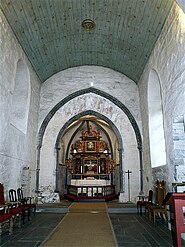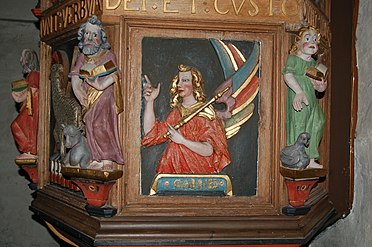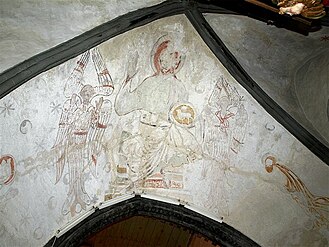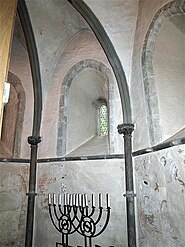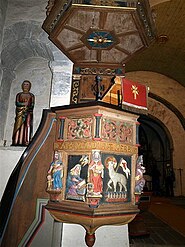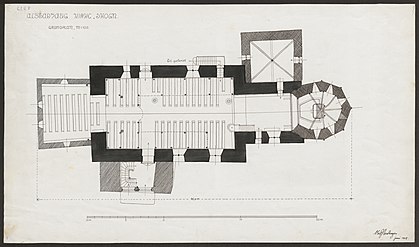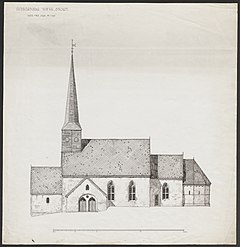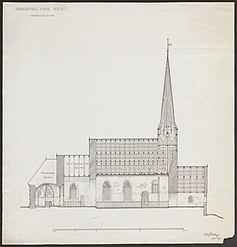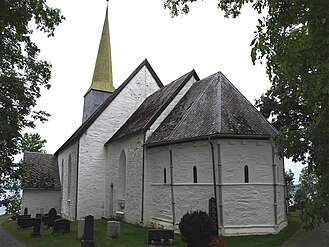Alstadhaug Church
History

The earliest existing historical records of the church date back to the year 1280, but the church was likely built during the mid- to late 1100s. It features elements from both Romanesque and Gothic architecture. The church has a rectangular nave measuring about 20 by 12.5 metres (66 ft × 41 ft) and a narrower, square chancel with a lower roof line that measures about 8 by 8 metres (26 ft × 26 ft). The church building is built of stone with wood ceilings. Dendrochronology surveys of the roof show the timber dates to the years 1166–67. It is therefore likely that the church was completed around the year 1170. Construction on the church likely began 20 to 30 years before its completion (around 1130–1140).
Next to the church is Olvishaugen, a large burial mound. Olvishaugen measures 55 metres (180 ft) across and has a height of almost 6 metres (20 ft). It has not been excavated but estimates have dated it from the Iron Age (5th to 8th centuries AD).
The church originally had a large tower on the west end, but in the early 1200s the tower was dismantled and its stone was used to build an octagonal apse to enlarge the choir and two retaining walls along the southwest corner of the nave. A sacristy in stone was built on the north side of the choir in the early 15th century. Over the centuries the building has been remodeled several times and the floor plan has undergone several changes. The interior features the remains of murals from the 13th century with famous Biblical motifs. The altarpiece dating from the 1650s was carved by Trøndelag-based artist and craftsman Johan Johansen (d. 1657) who was called a woodcarver (bilthugger) and painted by Johan Hanssønn listed as portrait artist (kontrafeier). Around the year 1700, a new porch was built on the southwest entrance to the church. In 1788, a new tower and spire was built on top of the nave's roof.
In 1814, this church served as an election church (Norwegian: valgkirke). Together with more than 300 other parish churches across Norway, it was a polling station for elections to the 1814 Norwegian Constituent Assembly which wrote the Constitution of Norway. This was Norway's first national elections. Each church parish was a constituency that elected people called "electors" who later met together in each county to elect the representatives for the assembly that was to meet at Eidsvoll Manor later that year.
Media gallery
-
Church nave
Credit: Hideko Bondesen -
Pulpit details, angel Gabriel
Credit: Arnstein Rønning -
Fresco over apse arc
Credit: Hideko Bondesen -
Details of octagonal apse
Credit: Hideko Bondesen -
Credit: Hideko Bondesen -
Church floor plan
-
Side view
-
Side view
-
Exterior side view
-
Chancel and apse view
See also
References
- ^ "Alstadhaug kirke, Skogn". Kirkesøk: Kirkebyggdatabasen. Retrieved 5 June 2021.
- ^ "Oversikt over Nåværende Kirker" (in Norwegian). KirkeKonsulenten.no. Retrieved 30 March 2018.
- ^ "Alstadhaug kirke". Trøndelag Historiske Norge. Retrieved 1 September 2018.
- ^ Brovoll, Asle K. (1999). Alstahaug kirke : en kulturskatt (in Norwegian). Alstahaug: A.K. Brovoll. ISBN 8299510600.
- ^ "Alstadhaug kirke" (in Norwegian). Sør-Innherred prosti. Retrieved 27 May 2011.
- ^ "Alstadhaug kirke". lokalhistoriewiki. Retrieved 1 September 2018.
- ^ "Alstadhaug kirkested" (in Norwegian). Norwegian Directorate for Cultural Heritage. Retrieved 5 June 2021.
- ^ "Alstadhaug kirke". Norges-Kirker.no (in Norwegian). Retrieved 5 June 2021.
- ^ "Alstadhaug Church and the enormous burial mound". stiklestadpilgrimcenter.org. Retrieved 1 September 2018.
- ^ Sigrid Christie. "Johan Johansen, bilthugger". Norsk kunstnerleksikon. Retrieved 1 September 2018.
- ^ Erik Mørstad. "bilthugger". Store norske leksikon. Retrieved 1 September 2018.
- ^ Børge Nordbø. "kontrafeier". Store norske leksikon. Retrieved 1 September 2018.
- ^ "Valgkirkene". LokalHistorieWiki.no (in Norwegian). Retrieved 31 May 2021.
- ^ "Om valgene". Valgene i 1814 (in Norwegian). Arkivverket. Archived from the original on 24 June 2021. Retrieved 31 May 2021.
